Apple's iPhone 4: Thoroughly Reviewed
by Brian Klug & Anand Lal Shimpi on June 30, 2010 4:06 AM EST- Posted in
- Smartphones
- Apple
- iPhone 4
- Gadgets
- Mobile
FaceTime
Meet Manveer. I’ve known him since I was in the 6th grade. Somewhere around the 8th grade we started a ritual of calling each other every day after school and talking about video games, computers and dumb things that happened at school. We talked on the phone for hours. Back in those days we would even play the same game on separate computers while talking on the phone. It was a precursor to voice chat in gaming networks like Steam or Xbox Live. It was ridiculous amounts of fun.
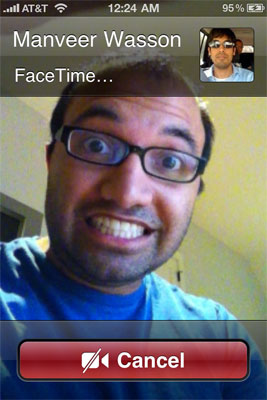
Manveer is up in the corner, the crazy guy is yours truly
Tonight Manveer and I FaceTimed. It’s the feature I wish we had when we were back in middle school. These days it’s a lot harder to explain why you’ve got some random dude’s face on your phone talking to you about completely pointless things at 12:54AM on a Tuesday night. I spent part of the chat covering one of the lights in my room with my head and calling it an Anand Head Eclipse. At the risk of further embarrassing myself publicly, it was fun.
For those of you who don’t know, FaceTime is Apple’s VoIP protocol built into the iPhone 4.
Granted we’ve been able to do this sort of thing for quite a while now over instant messenger networks. Integration into your smartphone is just the next logical step, and in the right conditions it works very well.
 |
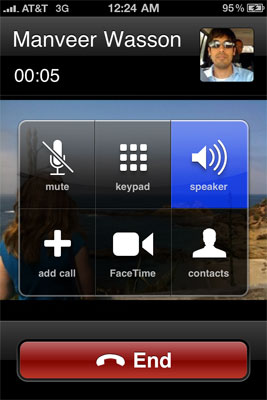 |
The first requirement is that both users need to have an iPhone 4 obviously. Both also need to be on WiFi. While the FaceTime icon will appear if you call another iPhone 4, if you try to activate the connection you’ll get this error unless you’re on WiFi:
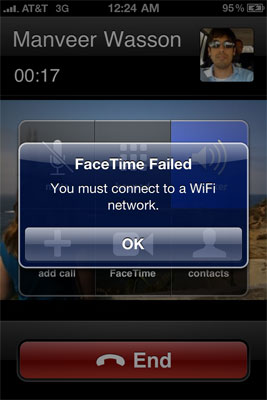
With a bit of poor UI design Apple will actually display a FaceTime icon with a question mark in it if you call another iOS phone. Trying to activate FaceTime however gives you an error.
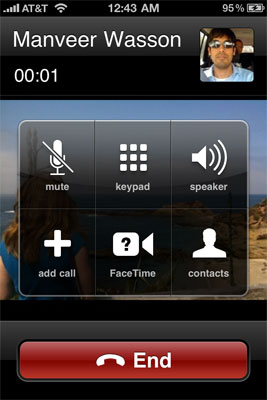 |
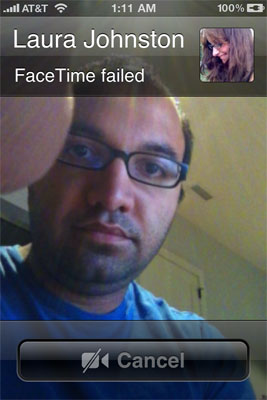 |
FaceTime requires roughly 100 - 150Kbps of bandwidth in both directions to work smoothly. The download should be fine but the upload is pretty high given that many broadband providers in the US are ridiculously stingy with their upload bandwidth. For FaceTime to work well you can’t be uploading or downloading anything large in the background, or if you are just throttle everything else to give you enough bandwidth to work with.
The next problem with FaceTime is the iPhone 4 lacks an absolutely necessary integrated stand. HTC got it perfect with the EVO 4G, unfortunately the 4 has no such thing. The closest you can get is Apple’s iPhone 4 dock, it’ll set you back $29 but it’s necessary to prevent you from getting tired holding your phone out in front of you. Laying the 4 down on your desk while you FaceTime just gives the person on the other end of the line a great view of your nostrils. Not very welcoming.

This is the on-table view of FaceTime, you need a stand
Even once you’ve met all of the requirements it’s still not a guaranteed thing. Even with ample bandwidth I had one FaceTime chat stall in the middle of the chat. My incoming feed froze and I had to wait a couple of seconds for it to resume. I also had a problem where FaceTime would fail to start on the first try. A subsequent try fixed it.
As you'll see in our camera investigation, the low light performance of the 4's front facing camera is horrid. Couple that with FaceTime and you will get bad image quality if you're not in a well lit room:

Ugh, what is this, 1998?
While in FaceTime you can easily switch between front and rear cameras by tapping the camera icon in the lower right corner. Unfortunately the compression on the video is enough to render text illegible while in FaceTime:
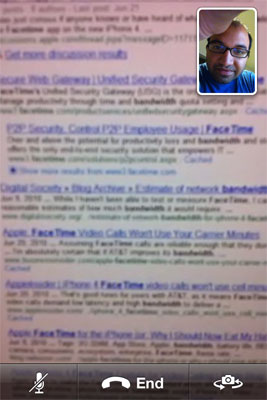
This was taken using the rear facing camera over FT
Obviously everyone knows where FaceTime is going. Apple is supposedly opening the protocol up to all developers, so you’d be able to theoretically build desktop and other smartphone FaceTime clients. And ultimately as mobile broadband speeds (hello WiMAX and LTE) improve the WiFi requirement will be dropped. But is it a good feature today?
It really depends on who you know with an iPhone 4. If you’ve got a Manveer, absolutely - the feature is worth it. If you have a bunch of casual acquaintances with iPhone 4s, probably not. It’s only useful if you know the person on the other side very well.
There is one other major benefit to FaceTime. Once enabled your call is routed over WiFi to the Internet, not AT&T’s 3G network. It doesn’t use any of your plan’s minutes and more importantly, voice quality is much improved over a regular 3G/EDGE phone call. It’s VoIP, not a crappy cell connection. Even if you just cover the camera it’s actually better to make calls over FaceTime than 3G based on the sound quality alone.










270 Comments
View All Comments
JAS - Wednesday, June 30, 2010 - link
The build quality of the iPhone 4 is outstanding. It reminds me of Nagra (Swiss-made) professional tape recorders I have used. Very solid.The edges of the iPhone 4 are not as smooth as those on the iPhone 3GS; but they aren't "sharp" or prone to cutting your pants when you slide the device into your pocket.
Still, I would want to use a rubber/silicone "skin" on the iPhone 4, not just a bumper, primarily to improve its grasp.
jsbruner - Wednesday, June 30, 2010 - link
I see the reception bar issue as well but do not experience any dropped calls because of it. However the biggest issue I have is with the proximity sensor. I have accidentally hung up numerous times because the screen lock turns off and the buttons become active. I watched myself in a mirror talking and I see the phone flickering on and off. Have you seen this issue at all? Would the bumper minimize this issue?Great article.
Wolfpup - Wednesday, June 30, 2010 - link
While in theory I'd love higher resolution displays on monitors, in practice they're already too high, and can't get any higher until somehow operating systems are able to offer true resolution independence where ANY program (even if it's written in 1988) will be flawless scaled so it's the right size at a given resolution. So far the ONLY example in the computer world of this being done right is on Palm devices, where they just quadrupled the resolution and on older programs 1 pixel = 4 real pixels. Presumably it's the same on iOS.But until OSes can do that that successfully on ANY content on ANY monitor at ANY resolution, raising the resolution is a TERRIBLE idea, as we're already WAY past the point of usability on a lot of displays, since stuff just keeps shrinking rather than adding detail.
inperfectdarkness - Wednesday, June 30, 2010 - link
"If there's one thing I hope the iPhone 4 display does, it's generate demand for 300 PPI level desktop displays - the era of 110 PPI displays being the norm needs to end now."i could not have said it better. 1080p on a 17" screen is pathetic for a laptop.
minememy21 - Wednesday, June 30, 2010 - link
I registered just for the sole purpose of saying thank you to Brian and Anand.I really appreciate the amount of work and objectivity you've put in this review. I don't know of any other site with the same level of dedication and thoroughness.
Please don't pay attention to the few, vocal, and overly sensitive anti-apple crowd and just continue writing the way you do.
HilbertSpace - Wednesday, June 30, 2010 - link
"Perhaps even use diamond vapor deposition (like they did with the glass screen atop the iPhone 3GS) to insulate the stainless steel from users." -The Real Story on iPhone 4's Antenna.There's no way apple used physical vapor deposition (PVD) on the iPhone 3GS, way too expensive! Supposedly a Nokia Vertu phone adds a TiC coating - the cost - oh only ~$15000!
gronkman - Wednesday, June 30, 2010 - link
The word on the grapevine is that the antenna issue will be dealt with by an upcoming software update. What I am interested in is whether it will really change the antenna attenuation, or whether it will "fix" the bars just by not showing the bar degradation. I'm hoping AT will do an in-depth look at the update when/if it comes out.thomas.magnum - Wednesday, June 30, 2010 - link
I am not sure what you mean when using 40% in the context of the bar. But I think you need to improve the discussion of dB. Because it runs on a log scale, changes in dB are more complex than just looking at dB1-dB2 and computing percentage. You really need to think about 10^(dB/10). I would bet that the bars are setup to be representative of a dB scale. NOT simple percentages base on dB numbers, like you're trying to do.The0ne - Wednesday, June 30, 2010 - link
Your comment reminds me of richter scale :) Most people will look at 6.0 and 7.0 and say oh that's nothing hahaha If only they knew they'll be completely shocked. Sorry, I had a good laugh out of this.strikeback03 - Thursday, July 1, 2010 - link
Of course that is also assuming they think the Richter scale is still in use.